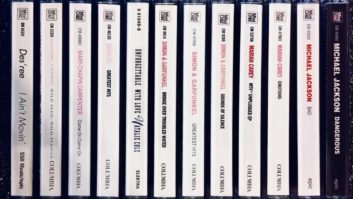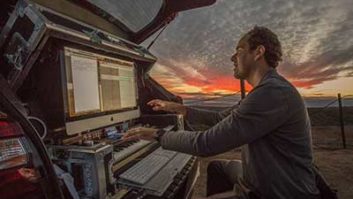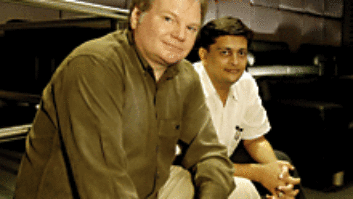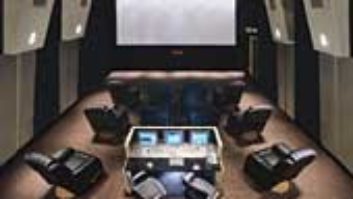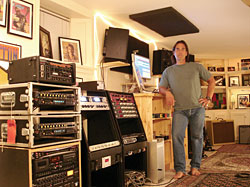
Mark Cattano and his Bob Quine collection at Magneto Studios
photo: Inge Fonteyne
Take the irresistible attraction to indulge your whims in the recording studio and throw in the ghost of a rock guitar icon, and you have the spirit of Magneto Studios (Greenwich, Conn.). Founded by owner Mark Cattano just up the road from New York City, Magneto shows what can happen when a professional musician gets a little taste of audio engineering.
A guitar-wielding veteran of metal acts and a solo project that enjoyed regional success in the 1990s, Cattano was increasingly impressed by the results that his colleagues were getting from their living room setups. “A light bulb went over my head, so I ended up getting one of those Boss BR1180 hard disk recorders,” Cattano explains. “I got a cheap pair of monitors, plugged my guitar in and you know what happens after that! You get a titanium laptop, better monitors, a MOTU, and it’s been this money hole ever since.”
Fast-forward to 2005, when Cattano’s move from New York City to a former guest cottage in more family-friendly Connecticut took him out of his living room and into a larger basement space — perfect for a fully functioning personal studio. While Cattano readily admits that the L-shaped room lacks the classic trappings of an acoustically ideal space, careful attention to the signal path brought extremely satisfying results for recording drums, guitars, vocals and more. “The front end is where I really shined,” Cattano confirms of the setup. “The last two records I did were mixed and recorded on an old Neve console, so I got it in my craw that I wanted some Neve modules, which are super-expensive. Fortunately, now we’ve got these Nevealikes, and I ended up getting four channels of Vintech X73i, which is their less-expensive 1073 reproduction. It sounded just like going through my friend’s board, except none of the pots were scratchy! It had the same Neve midrange fuzz that my ears have grown to love.
“That’s my mic pre/EQ front end for tracking drums. All I’m doing is sticking an AKG D112 on the bass drum, Shure SM57 on the top of the snare and taking two KSM 44s on the overheads,” he continues. “They go through my four mic pre’s, and the drums sound phenomenal.”
At the computer, Cattano experienced audio interface issues running Logic 7 on his Mac G5 until someone tipped him off about the RME Audio Hammerfall DSP Multiface interface for eight channels of analog I/O and sweet stability. “I’m all analog — I don’t have any MIDI stuff in my rig,” he says. “I’m a rock ‘n’ roller. If I’m just recording drums, guitar, bass and vocals, all the guys I play with can play. We lay down a track live, and I use Logic like a tape deck: I press Play, Record and Stop.”
One man who probably would have been happy to hear about Cattano’s philosophy is the late Bob Quine, an uncompromising guitar innovator who made his mark playing with such artists as Richard Hell & The Voidoids, Lou Reed, Brian Eno, John Zorn and Matthew Sweet. Cattano and Quine first met at one of New York City’s main hubs for six-stringers, Carmine Street Guitars, and built a friendship that lasted until Quine, stuck in a deep depression after his wife’s untimely death in 2003, tragically took his own life in May 2004. In addition to an impressive musical legacy, Quine also left behind an astounding collection of gear: approximately 250 guitars and basses, 50 amps, 300 effects boxes and much more.
To Cattano’s amazement, the collection’s caretakers informed him earlier this year that he would be given priority access to this gear to purchase. “Bob was such an amazing player, and he really did influence a lot of serious cats,” Cattano recalls. “If you were talking gear with him and mentioned a classic guitar or amp you liked, he’d invariably say he had one, and he did.” With his choice of the Quine collection in front of him, Cattano selected such niceties as a Korg DD1000 digital delay, a 1985 Roland SRV2000 digital reverb, Trace Elliot Velocette Class-A guitar amp, 1982 Fender Twin Reverb II amp, Peavey Combo 300 bass amp and a dozen different pedals.
The result is an extra touch of magic for Magneto Studios. “I can’t tell you what a difference it’s made having some of Bob Quine’s equipment here,” Cattano reflects. “He was a heavyweight. The physical side of that coin comes when you bring home a 1959 Fender Bassman, plug it in, mike it up and play it back. A smile definitely comes across your face.”
